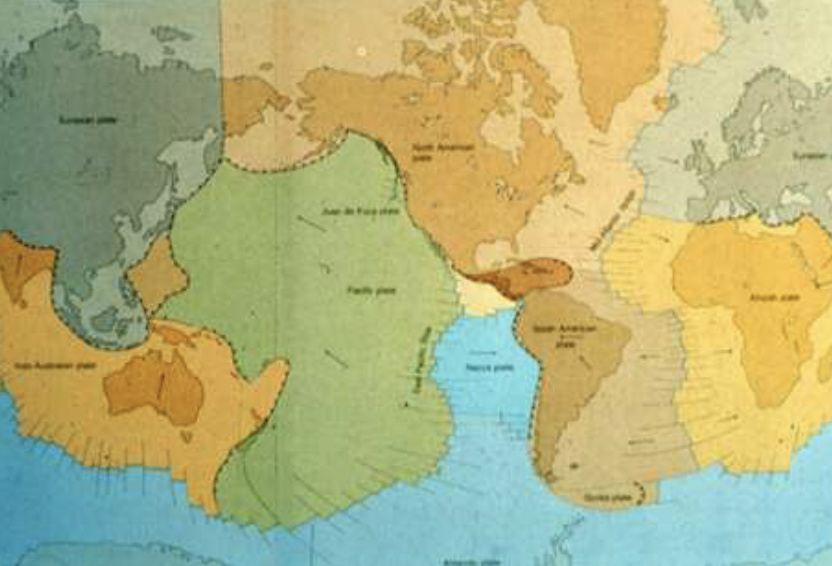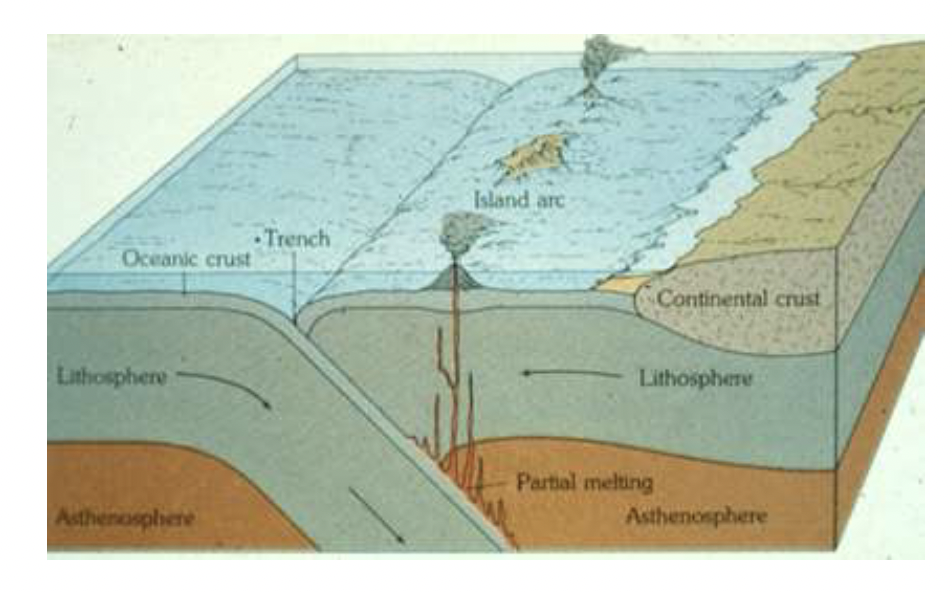Plate Tectonics
Earth’s Surface
- Dynamic
- Surface continually shaped by erosion and mountain building
- Erosion takes place when precipitation falls on land, wearing away at rocks and landforms
- Mountain building takes place mostly underground, driven by forces deep within the Earth
Earth’s Internal Structure
- Three basic layers: core, mantle, crust
- Each layer has further subdivisions within it
- Core
- Inner core is solid (metallic)
- Outer core is liquid (molten)
- Very hot (contains some heat left from when the earth first formed and some heat generated by ongoing radioactive decay)
- This heat escapes outward toward the surface through the mantle
- Mantle
- Consists of rock that would feel solid if touched but rock that can move and deform
- This is behavior that a physicist would describe as elastic – a deformable solid
- Under heat/pressure from core, the rock of the mantle can move slowly
- Two parts: lower and upper mantle
- Upper mantle is the more malleable part (aka asthenosphere)
- Crust
- Solid brittle rock that comprises Earth’s surface
- Very thin relative to the rest of the planet; thin shell of rigid rock around a deformable interior
- Two types: continental and ocean crust
- Continental crust: relatively thick and made dominantly of rock with high silica silicate minerals (rock often referred to as felsic – high silica rock); comprises continents
- Ocean crust: relatively thin and made dominantly of rock with low silica silicate minerals \n (rock often referred to as mafic – low silica rock); comprises oceans
- Essentially, the continental crust is thick and light; the ocean crust is thin and heavy
- Under the crust is a layer of solidified mantle rock
- Combined with the crust, this layer comprises the lithosphere
- Under the lithosphere is the upper mantle
- Not one cohesive shell; broken into pieces called plates
- Crustal plates or lithospheric plates

- Most larger plates contain both continental and ocean crust
- Crustal plates move (mobile crust)
- Plate tectonics: the movement of the crustal plates
Plate Tectonics
- Many major geological events take place on plate boundaries where they interact with each other
- A lot of plate tectonics theory centers around the dynamics of plate boundaries
- Three basic kind of plate boundaries
- Divergent boundaries: boundaries which occur where plates move away from each other
- Convergent boundaries: boundaries which occur where plates move toward each other
- Transform boundaries: boundaries which occur where plates move laterally past each other
Divergence
Plates spread apart (“rift”)
Divergence is driven from below by hot rising rock in the mantle which concentrates in certain areas of the mantle rather than being evenly distributed
- In ares of high heat flow, the hot mantle rock rises; the rising rock pushes up on the overlying crust and pushes it apart
- When the hot rising rock pushes up under a continent, the continent begins to crack and stretch and thins to create a rift valley – a long, narrow valley
- As the spreading continues, the rift valley floods with water and creates a narrow sea
- Eventually, the spreading sea opens into a full ocean basin
Most divergent boundaries occur in ocean basins and are marked by mid-ocean ridges
- Mid-ocean ridge: a large linear mountain range on the ocean floor
- The divergent boundaries form ridges because the ocean crust is being pushed up from underneath and pushed apart
- In the center of the ridge is a rift where the two diverging plates spread away from each other at a rate of 4-5cm/year
- In the gap between the two spreading plates hot rock from the underlying mantle
rises up and solidifies to form new crust – new ocean crust
- As the plates spread, new crust is continuously added to the back side of the plate
All major ocean basins have mid-ocean ridges
- Eg. mid-Atlantic ridge that runs north to south for the length of the Atlantic ocean
Convergence
- Plates collide
- Subduction: when one plate is pushed downward in a convergence
- This is why convergent boundaries are also called subduction zones
- New ocean crust is created by divergence and old crust is destroyed by convergence → essentially recycling
- Three subtypes of convergent boundaries:
- Ocean crust / ocean crust
- One plate is subducted under the other plate
- Marked by a deep ocean trench
- Deep ocean trench: a linear trench significantly deeper than the rest of the ocean floor

- As one plate subducts under the other, the subducting plate experiences friction as well as higher temperatures and pressures, so its crust begins to melt
- The melting crust produces magma that rises up toward the surface, some of which erupts to form volcanic islands parallel to the deep ocean trench
- Volcanic island arc: the chain of volcanic islands parallel to the trench
- Eg. volcanic Japanese islands
- Ocean crust / continental crust
- Also marked by deep ocean trenches
- Ocean crust is almost always subducted since it is heavier
- Same process for volcano formation may occur, but volcanoes are located on the continent rather than separate islands
- The force of the plate collisions also causes the formation of mountains
- Continental crust / continental crust
- Results in intense mountain building, crustal deformation, and uplift
Transformation
- One plate slides laterally past another
- Eg. San Andreas fault of California (Pacific plate/North American plate)
Effects of Plate Tectonics
- All plate boundaries are sites of crustal movement and geologic activity
- One exception to this idea is Hawaii, a mid-plate hot spot
- Under the Pacific plate lies a small area of concentrated heat flow in the mantle
- When heat rises within the mantle, the mantle’s upper layer begins to rise
- Rising hot rock generates magma that rises through the crust and erupts to create a volcano on top of the plate and, as the volcano grows, a volcanic Hawaiian island
- The Pacific plate keeps moving, so the island moves with it
- Then, a new volcano and a new island form on top of the hot spot and the process continues
- The current volcanic activity is happening on the southern end of the big island of Hawaii
- Each island gets progressively older northwestward through the island chain, having moved farther from the hotspot over time